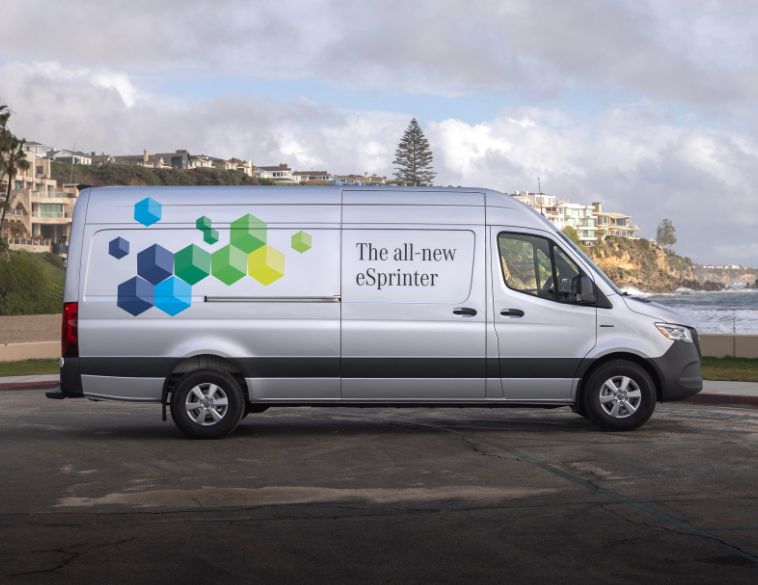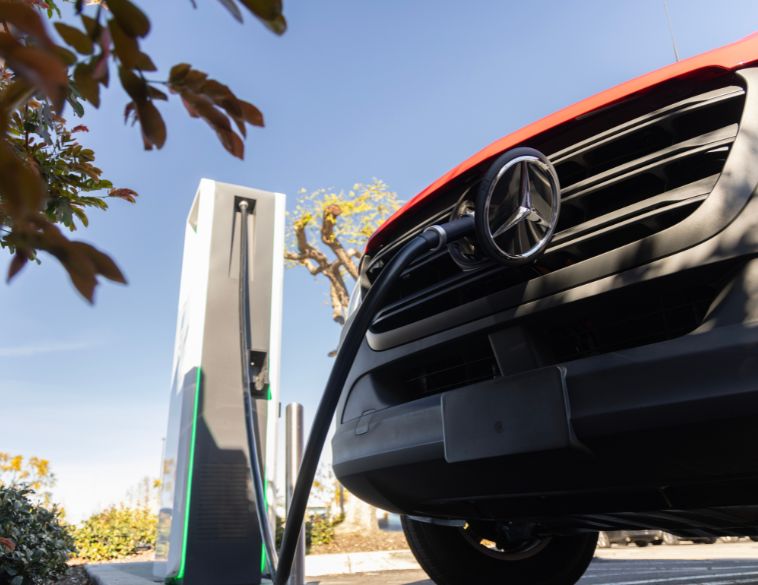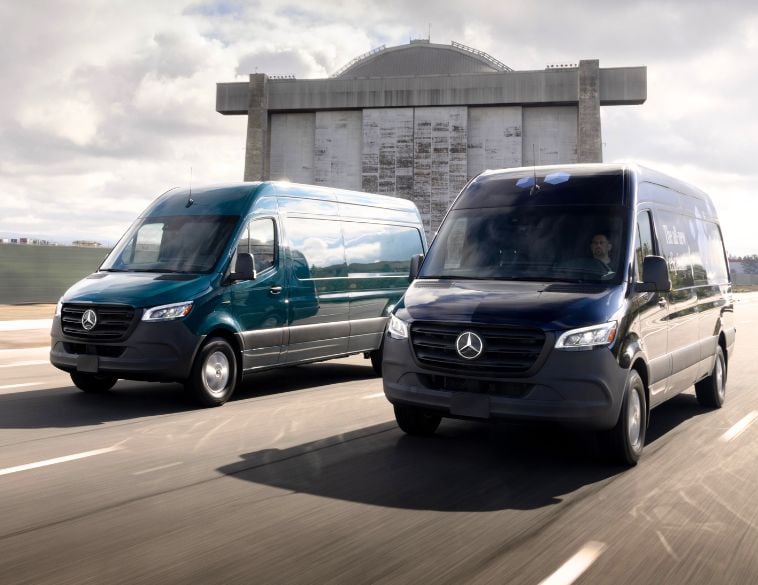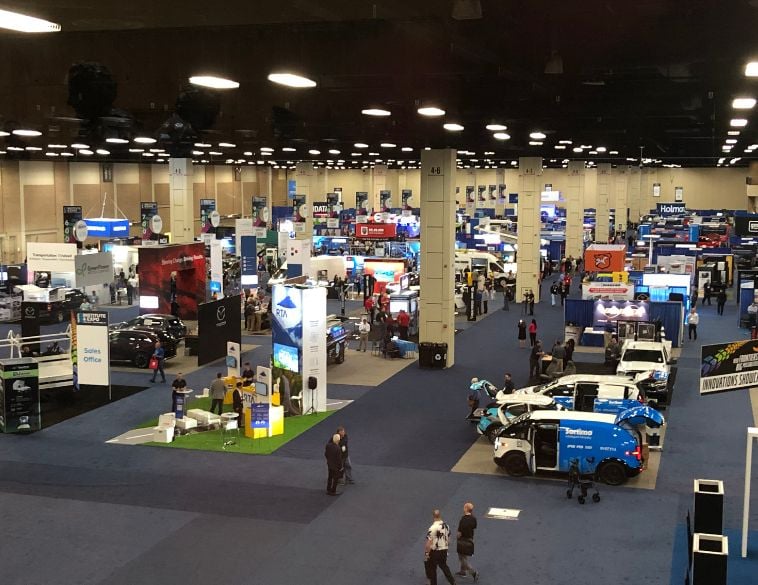Mercedes-Benz eSprinter offers the strengths of its traditional counterpart, wrapped in a zero-tailpipe emissions format.
Over the last few years, the topic of battery electric vehicles has dominated almost every conversation around fleet management. Yet while BEVs continue to dominate the news, there are some specific considerations, particularly when it comes to commercial fleet applications. Not only are range and safety important, but so is ease of use and operation, reliability, range, payload, versatility, and total cost of ownership.
A good example is the commercial van segment. In North America today, full-size vans are offered from the likes of Mercedes-Benz, Ford, General Motors and Stellantis. All, bar the GM twins are European in origin and Mercedes has the distinction of being the pioneer in this genre, having introduced its popular Sprinter to the North American market back in 2001.
Strengthening the portfolio
Now, the three-pointed star is taking a new direction as it aims to strengthen its portfolio of battery electric vehicles. The eSprinter is designed to supplement the traditional diesel-powered version and provide fleets with a vehicle that delivers zero emissions at the tailpipe. To find out what this new BEV Benz van is all about, Autosphere hopped on a plane to Southern California, the leading battery-electric vehicle market in North America, to find out.
At launch, the eSprinter comes in just a single configuration, as a high-roof van with a 170-inch wheelbase. Under the cargo floor, is a 113 kilowatt/hour battery, that Mercedes claims enables the eSprinter to travel a distance of up to 440 km (273 miles) based on the WLTP global vehicle test cycle. This consists of a 30-minute cycle split into four different speed phases:
- Low (max speed 56.5 km/h-average speed 25.7 km/h-9.49 min duration)
- Medium (max speed 76.6 km/h-average speed 44.5 km/h-7.13 min duration)
- High (max speed 97.4 km/h-average speed 60.8 km/h-7.34-min duration)
- Extra High (max speed 131.3 km/h-average speed 94 km/h-5.23 min duration)
Fleet customers need to bear in mind that these numbers are conducted under specific test conditions and real-world performance is likely to differ significantly, depending on where they operate their vehicles.
Nevertheless, for last-mile deliveries, and those that are operating in urban environments where vans are being used to constantly drop off and pick up packages, a full, battery-electric van like the eSprinter makes a lot of sense, especially if it can be charged at a central depot overnight.

Variety of conditions
Our experience with the eSprinter took in a variety of different driving environments, stop and go city traffic, open two/four-lane road, and interstate highway. One thing that stuck out was how familiar the eSprinter feels from behind the wheel. Yes, you’ve got a charging gauge instead of a tachometer, and the small column mounted shift lever can take a little getting used to, but anyone familiar with driving a traditional Sprinter, can easily feel right at home. The electric version delivers a very compliant ride for a commercial van, whether loaded or unladen, helped in this case, by the long 170-inch wheelbase of the launch configuration. Due to the low centre of gravity facilitated by the underfloor battery pack, it also handles very well for a high roof van and the steering is nicely weighted at virtually all speeds.
A big benefit is the amount of torque generated by the rear mounted electric motor, which weighs just 286 lbs. Offered in either 100 or 150 kilowatt/hour (High Output) versions, it delivers plenty of grunt where you most need it, at low and medium speeds. Accelerating onto a freeway, or, having to move quickly to switch lanes in busy traffic is largely effortless and noticeably easier than in your typical gasoline or diesel Euro-style delivery van, which tends to satisfy all-out grunt for fuel efficiency.
While underway, drivers have the choice of operating the eSprinter in one of three different modes. “Comfort” [which we drove our test vehicles in the majority of the time], delivers the full range of torque and performance capability, while “Economic” is designed to increase efficiency of the electric motor and battery pack. “Maximum Range,” goes a step beyond “Economic”, further reducing motor output as well as limiting output of such features as climate control—all in the quest to extract every last mile of electrical charge.

Regenerative braking
When driving electric vehicles, a big shock to those that aren’t used to them is the regenerative or recuperating braking, when the throttle is lifted. On some, the sensation feels like the brakes are literally dragging and takes getting used to. In the eSprinter, the amount of regenerative braking can be adjusted via steering wheel paddles, which offer five different modes D, D-, D+, D++ and D Auto. This enables the driver to tailor the amount of regenerative braking force to their specific liking as well as driving situation. What we did notice, after a considerable amount of time driving, such as performing in stop and go situations as well as ascending and descending hills, was that braking felt far more like a conventional vehicle compared with most EVs and hybrids we’ve driven. The drag sensation was almost completely absent, yet braking remained steady and secure, especially considering the size and weight of the eSprinter.
An added bonus of the D Auto feature; is that it will enable the eSprinter to automatically define the amount of regeneration required based on traffic conditions. A dash mounted ECO Assist indicator is designed to prompt the driver when they can take their foot of the accelerator, allowing the eSprinter to select the right amount of braking recuperation. The D Auto feature is most helpful and not only enables drivers to maximize efficiency and safety out on the road—but also aids in improved TCO and risk mitigation for fleets—an important consideration for those looking at adding BEV vans to their product portfolio.
Digital mirror
While in motion, a big benefit is the optional digital rear-view mirror. Anybody that’s driven a traditional, windowless cargo van, knows that it can often be a pain to rely solely on the exterior mirrors, particularly when driving on multi-lane highways or busy main roads.
With the digital mirror, the driver has an unobstructed view of the rear of the vehicle. It functions like a traditional, internally mounted rear-view mirror would, except, in this case, the image comes courtesy of digital imaging transmitted by a High Dynamic Range camera installed in the exterior rear end of the roof. It also makes manoeuvring the van easier at low speeds and in confined spaces, further adding safety and improving risk prevention for fleets.
A big part of any commercial van purchase concerns packaging efficiency, and one reason why the Sprinter has proved so popular is that it maximizes interior space, due to its low load floor and available high roof configuration. The eSprinter is no exception, offering 13.8 cubic metres (488 cubic feet) of space, and a range of upfitting solutions, since the underfloor battery sacrifices no usable cargo space, making it an easy transition from those used to the traditional gasoline and diesel-powered versions.

You can’t get far in any BEV vehicle discussion without referencing charging options and capabilities. On the eSprinter, the charging receptacle is located under a flap behind the famous three-pointed star logo in the middle of the front fascia assembly. Mercedes-Benz provides the option of both Alternating Current (AC) and Direct Current (DC) charging in order to maximize flexibility. The on-board charger has a maximum power output of 9.6 kilowatts when used in conjunction with AC current and a Level 2 charger. In such circumstances, the on-board charger converts the current in the vehicle to AC. On the DC side, Mercedes-Benz has designed the eSprinter to handle 115 kilowatts at fast-charging locations, with the ability to reach 80% charging capacity in slightly more than 40 minutes.
Besides charging, features another big factor on whether purchasing or leasing a BEV vehicle makes sense, includes the charging network that supports it and how accessible and easy to use it is. Mercedes-Benz offers the “Mercedes me Charge,” that integrates multiple charging point operators under a single umbrella. Therefore, a fleet driver in an eSprinter, has the ability to access locations provided by BC Hydro, ChargePoint, Electric Circuit and FLO, which runs to over 20,000 charging stations across Canada, while at the same time, offering a seamless and convenient payment experience at each charging location.

Careful consideration
While in practice, charging can present a significant challenge, as Canada’s extreme weather has a notable impact on battery capacity/performance and charging locations aren’t always available or operational. With careful consideration however, fleets can optimize BEV vehicle operation, employing them in roles and environments where they make the most sense from a TCO and efficiency standpoint.
To provide potential customers with a greater incentive to consider the new eSprinter, Mercedes-Benz provides an integrated (and comprehensive) service package. This includes maintenance in accordance with the vehicle’s Operating Instructions, manufacturer specifications and Service Booklet, as well as covering the first four maintenance services within the first four years of ownership (including regular inspection of high voltage components). The aim is to reduce TCO and make the vehicle more appealing to fleet buyers.
Additionally, Mercedes-Benz offers an eight-year, 160,000 km warranty on the battery pack, with the ability for customers to purchase an additional battery certificate. With this certificate, M-B guarantees that the maximum remaining capacity of the high-voltage batteries within the battery pack will not be less than 70% of the initial capacity for an additional 140,000 km, bringing the total to 300,000 km or eight years of coverage, whichever comes first.
Pricing
The final thing we will touch upon is price. At launch, and in the single, high roof, 170-inch wheelbase configuration, the eSprinter has an all-inclusive cash price of $107,273, ($108,783 for the High Output version) though note this is before federal and provincial rebates, which this vehicle is expected to qualify for.
Potential customers will need to confirm if they are eligible for both the federal IMHEV incentive program as well as any provincial incentives that are available on top of that, namely those in British Columbia, Quebec, and Newfoundland & Labrador.
Additionally, considering that many fleet customers choose to lease rather than finance, Mercedes-Benz Canada is offering rates starting at 5.99% for both new and existing customers.
VERDICT
There’s no question that Mercedes-Benz has built a deserved reputation in the commercial van segment in North America, due to the Sprinter’s combination of versatility and efficiency. The eSprinter aims to take that and apply it to the all-electric BEV sector, where it currently competes against another Euro rival, Ford’s E-Transit, as well as General Motors’ purpose-built BEV delivery van, the BrightDrop Zevo 400/600.
Based on our observations, the eSprinter has the right combination of versatility, comfort and practicality to make it a winner in this segment and there’s been considerable effort made to ease concerns regarding charging and Total Cost of Ownership. The biggest challenge, we feel, will be pricing. The e-Sprinter comes to market at a time where business costs are elevated, and compared to its diesel counterpart, which starts at $66,740 in 170-inch wheelbase, high-roof configuration, the eSprinter does seem like an expensive proposition, especially when you factor in the limitations of a pure Battery Electric Vehicle including range and charging time/access.
Nevertheless, when you look at some of its all-electric competitors, such as the BrightDrop 600 (with an MSRP of $136,615 and range of up to 402 km) and the Ford E-Transit (current cash purchase of $84,236 with an estimated range of 203 km), the e-Sprinter starts looking a lot more competitive.
While we feel that all-electric delivery vans aren’t yet ready for prime time (certainly as the staple of your fleet), they do make sense in certain applications and especially ones where they can make the biggest difference in terms of efficiency and improving air quality, such as short-range urban and suburban delivery. And for those reasons alone, the eSprinter is worth a look.
Vehicle: 2024 Mercedes-Benz eSprinter
- Base MSRP: $107,273
- Price as Tested: $108,783
- Engine Permanent-magnet synchronous electric motor
- Power Output: 113 kw/h usable battery capacity
- Range 440 km (273 miles)*
- Noteworthy Features / Important Selling Features: quiet operation, torquey electric motor, familiar layout, efficient cargo space/utility
- Chief Competition (top 3): Ford E-Transit, BrightDrop Zevo 400/600
*Based on simulated test WLTP cycle




